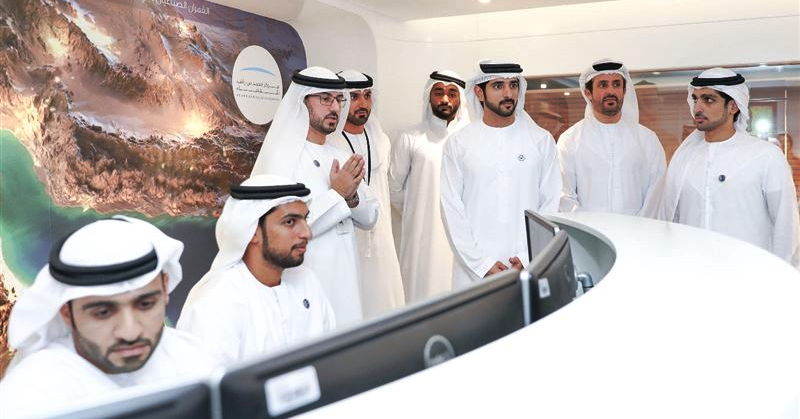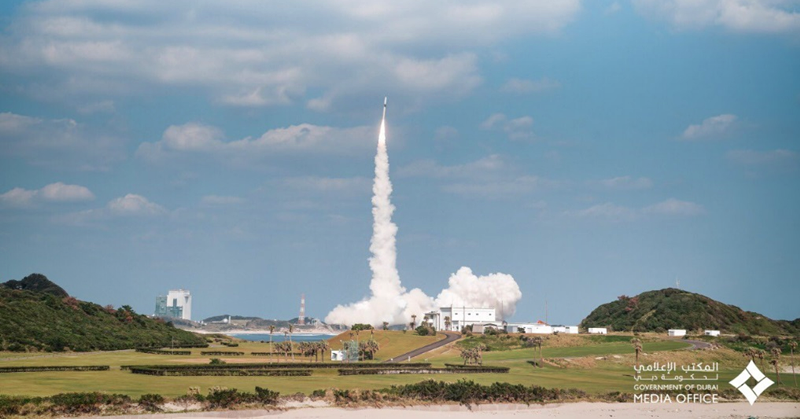The UAE welcomes a new milestone under its belt after the first Emirati-made satellite, the KhalifaSat, has been successfully launched into space from the Tanegashima Space Centre in Japan last October 29 (Monday), according to a report by the Dubai Media Office.
The satellite, which was named after His Highness, the president of the UAE, is proudly made in the UAE by a team of 70 Emirati engineers. The KhalifaSat is the fastest of its kind when it comes to high-quality image transmission. Travelling at a speed of 7 km/s, the satellite orbits the Earth for almost 14.5 cycles in a day.
فرحة فريق المحطة الأرضية في مركز محمد بن راشد للفضاء في لحظة وصول أول إشارة إتصال من #خليفة_سات. pic.twitter.com/bwrMAUVCd2
— MBR Space Centre (@MBRSpaceCentre) October 29, 2018
Contents
First UAE-made Satellite Launches into Space Successfully
The successful launch of the KhalifaSat strengthens the UAE’s mark in the development of its national space sector, with the Mohammed bin Rashid Space Centre (MBRSC) at the helm of the national space programme.
The Crown Prince of Dubai and Chairman of Mohammed bin Rashid Space Centre, His Highness Sheikh Hamdan bin Mohammed bin Rashid Al Maktoum monitored how the satellite first made contact with the ground station in the Mohammed bin Rashid Space Centre in Dubai.

Sheikh Hamdan extended his warm congratulations to UAE President His Highness Sheikh Khalifa bin Zayed Al Nahyan; Vice President and Prime Minister of the UAE and Ruler of Dubai His Highness Sheikh Mohammed bin Rashid Al Maktoum; Crown Prince of Abu Dhabi and Deputy Supreme Commander of UAE Armed Forces His Highness Sheikh Mohamed bin Zayed Al Nahyan as well as the entire Emirati nation on this monumental feat in the field of advanced space technology.
Sheikh Hamdan also acknowledged this achievement as an important milestone in establishing a bright future for the entire UAE. The Dubai Crown Prince further noted that the UAE has all the tools and facilities necessary to excel in the fields of the advanced sciences.
Historical moments at the launch location in Japan after receiving the news about capturing the first signal from #KhalifaSat from space through the ground station team at @MBRspaceCentre in Dubai pic.twitter.com/7d4PRtbIu9
— MBR Space Centre (@MBRSpaceCentre) October 29, 2018
Citing on the capabilities of Emiratis to develop world-class devices necessary for the furtherance of the global space industry, Amer Al Sayegh, KhalifaSat Project Manager at MBRSC, cited the following features which makes the KhalifaSat a cut above the rest:
Powerful 3D imaging & exceptional response/transmission speed
Operating on an advanced positioning system which enables the satellite to capture a large number of 3D images all at the same time, the KhalifaSat is able to gather images that will be used for monitoring environmental changes and the effect of global warming, effective implementation of urban planning and management, and coordinating relief efforts at times of calamities and natural disasters.
Also, the satellite has a sizable storage capacity and capability to download images and data at an extremely fast speed which allows more images to be captured within a shorter span of time.
Third satellite developed by MBRSC
Being the third satellite produced by the MBRSC following the success of the DubaiSat-1 and DubaiSat-2, the KhalifaSat differentiates itself from its predecessors in terms of its origin and development, as it is the first satellite fully developed by an entire team of highly qualified Emirati engineers.
General specifications of the KhalifaSat
The hexagon-shaped satellite is powered by four deployable solar panels integrated on the sides of the satellite bus. Two decks can also be noted within the structure together with an upper sun shield made of carbon fibre reinforced polymer (CFRP) which serves to protect the delicate camera system from temperature fluctuations and harsh environmental conditions which include exposure to radiation in space.
Ground control station in Dubai
The MBRSC ground station in Dubai is in charge of monitoring and providing support to the KhalifaSat, as well as maintaining its functions from the Earth. The ground system is composed of three (3) main subsystems:
- Antenna & Radio Frequency (RF) subsystem,
- Mission Control Station (MCS), and
- Image Receiving & Processing Station (IRPS)
The major function of the Antennae and RF subsystem is to communicate imaging orders, provide instructions for satellite activity, as well as collect information and download images through the X-band feed.
The successful launch of the KhalifaSat embodies the Emiratis’ capabilities in establishing the UAE as a global hub for space industry according to Al Sayegh.
Al Sayegh further explained that the KhalifaSat has set another milestone in the UAE’s drive to become the leader in the space industry, as well as in supporting its programme to further enhance space technologies and sciences for the future generations to come.
ALSO READ: WATCH – UAE Astronauts Undergo High-speed Test as Part of Space Training

Comments are closed.